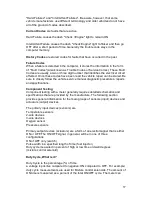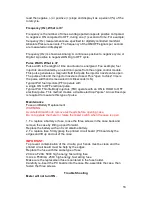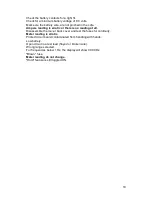
7
♦
Press the F-1860’s MAX/MIN button.
♦
Move the positive (+) test lead of the F-1860 around the positive (+)
battery terminal, without touching the terminal, but skimming the
surrounding battery surface. Readings of more than 0.5 V indicate
excessive battery surface discharge. Dirt, dust, moisture and corrosion
are all common causes of battery discharge. Clean the battery surface
with a baking soda and water solution, taking care that none of the
solution makes its way into the battery.
(2)
Static Battery Test (No load)
This test checks the battery charge state.
Turn the vehicle’s headlights on for 15 seconds to dissipate battery surface
charge.
IMPORTANT:
The ignition must be switched OFF in order to avoid damage to the vehicle’s
computer while connecting or disconnecting battery cables.
Disconnect the negative (-) battery cable from the battery.
♦
Set the F-1860’s rotary switch to the voltage position (V).
♦
Insert the black lead of the F-1860 into the
COM
socket, and the red
cable into the
V/
Ω
Ω
Ω
Ω
/RPM
socket.
♦
Connect the positive (+) test lead to the negative (-) battery terminal.
Readings under 12.4 V indicate an undercharged battery. Recharge the battery
before further testing.
NO LOAD TEST FOR STANDARD BATTERIES
F-1860 Reading
Battery charge
12.70 V
100%
12.54 V
75%
12.30 V
50%
12.18 V
25%
NO LOAD TEST FOR GEL BATTERIES
F-1860 Reading
Battery charge
13.00 V
100%
12.75 V
75%
12.50 V
50%
12.25V
25%





































